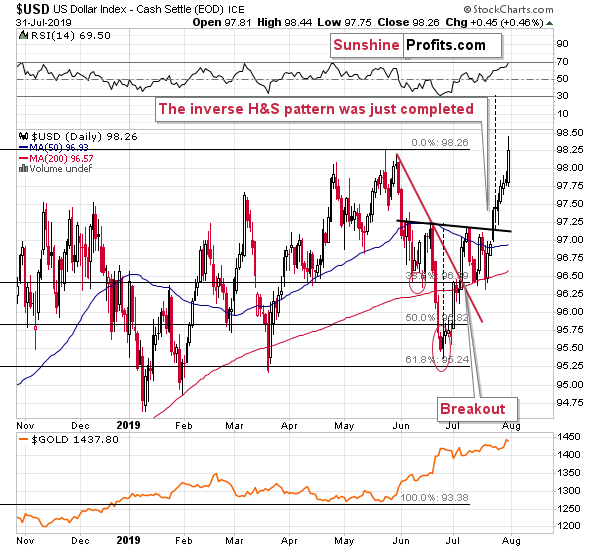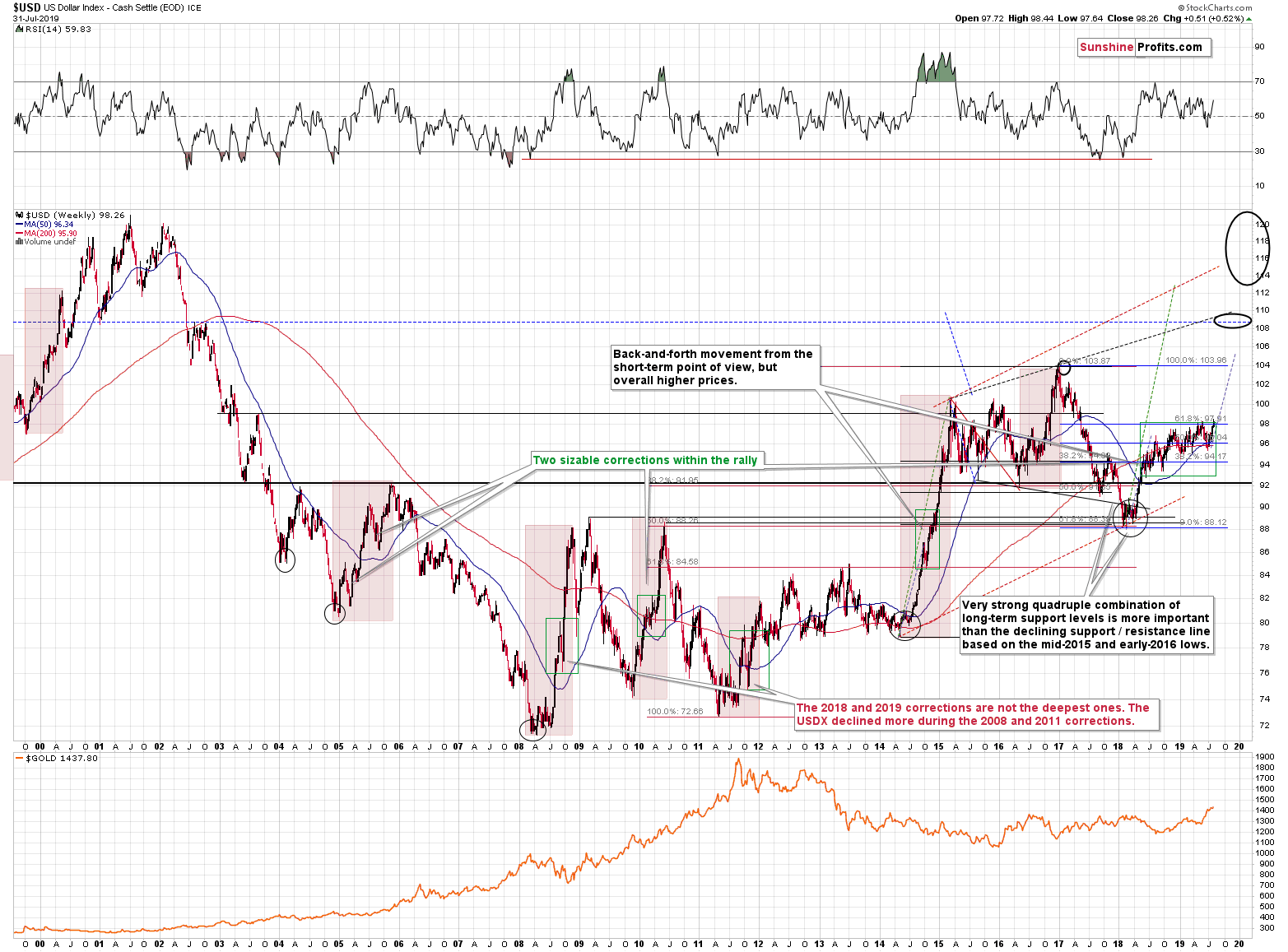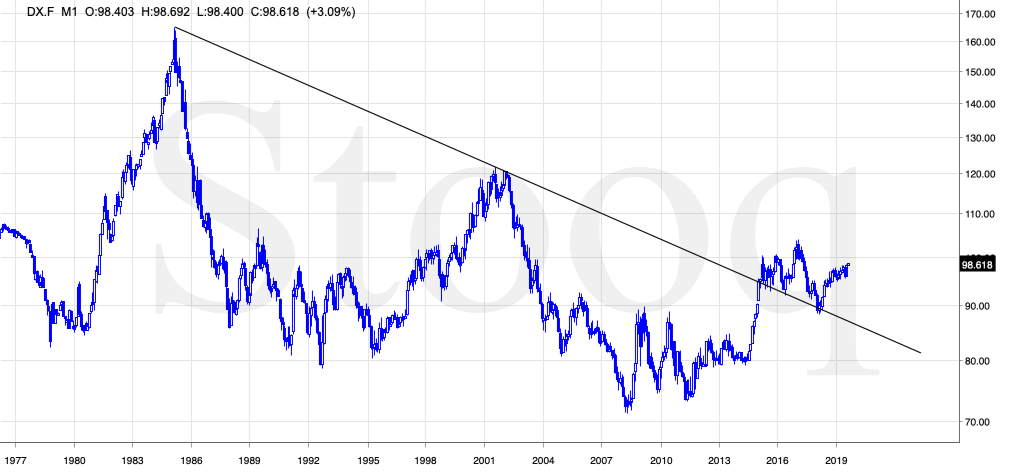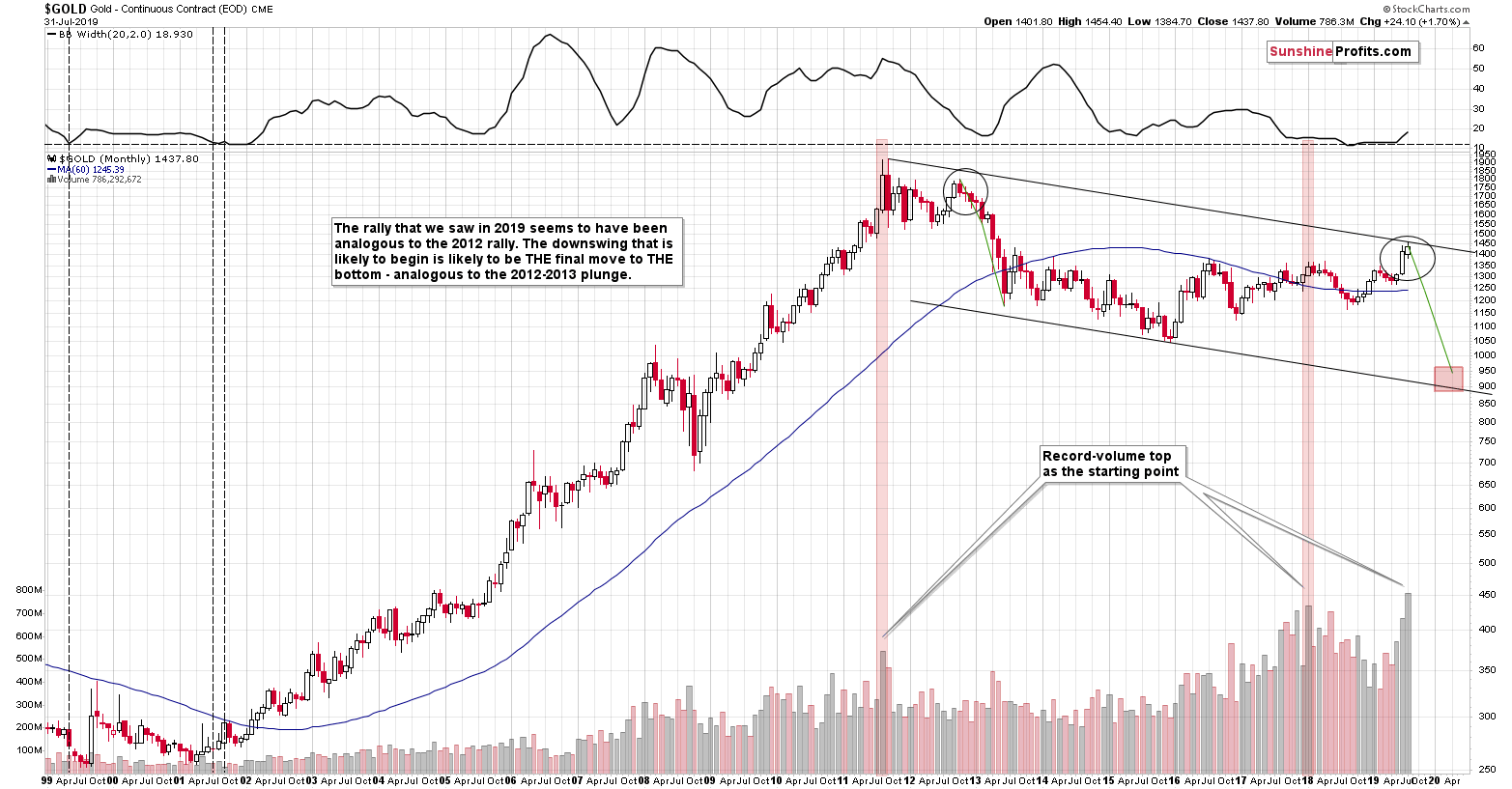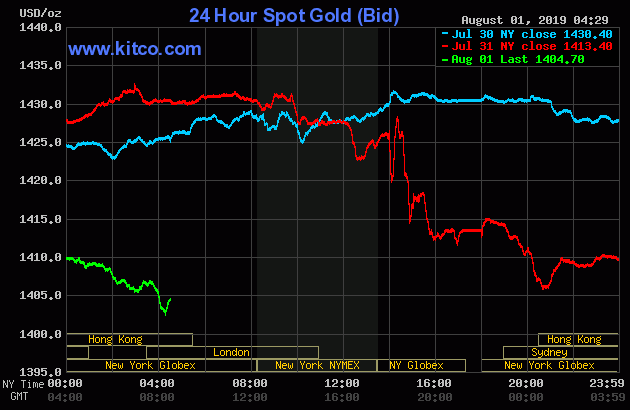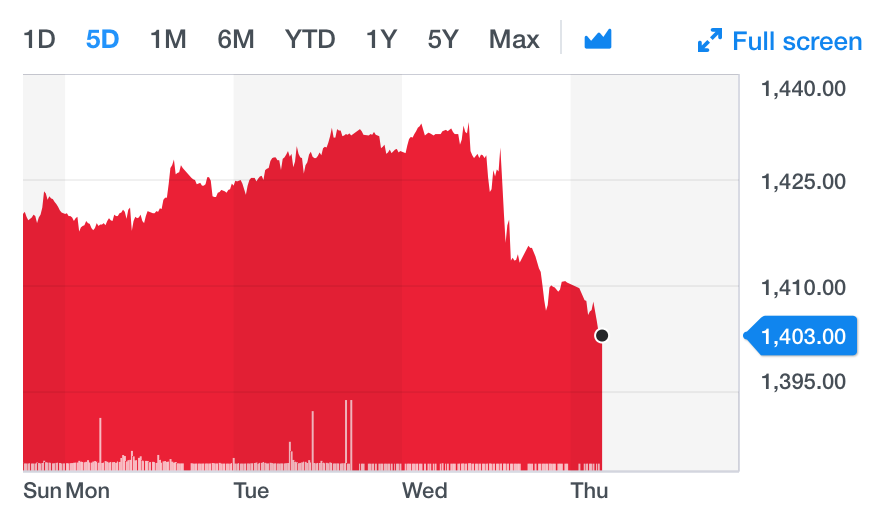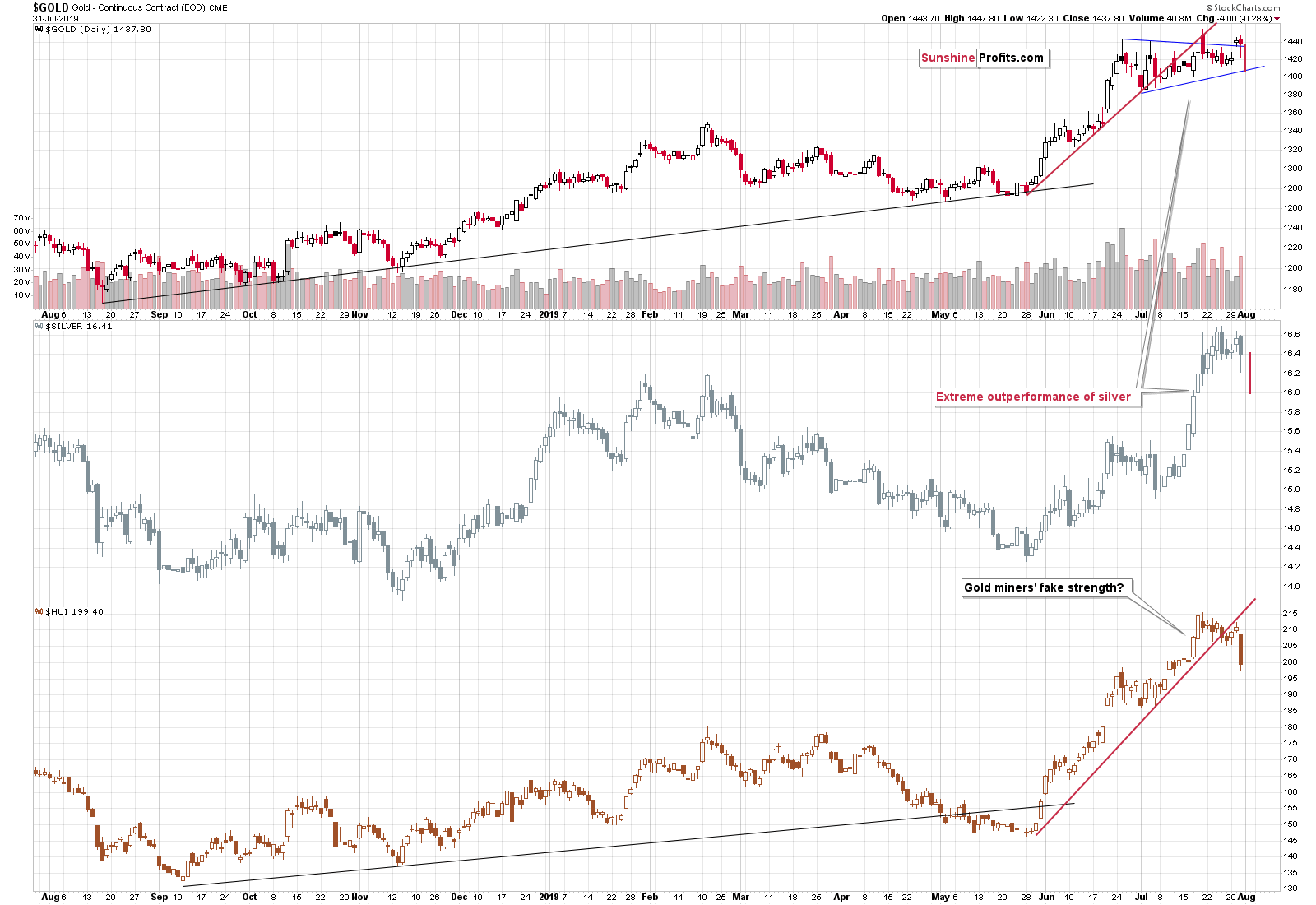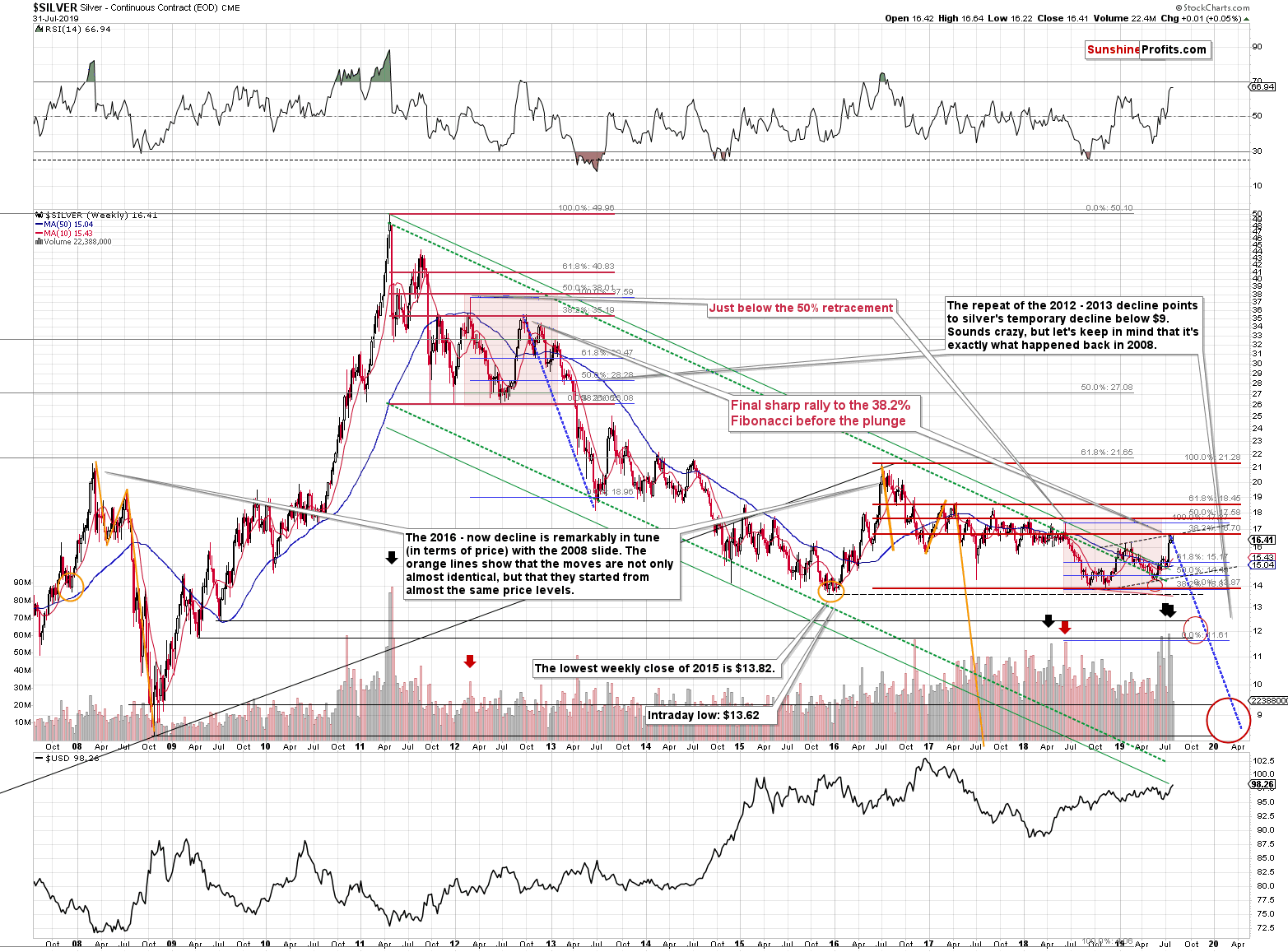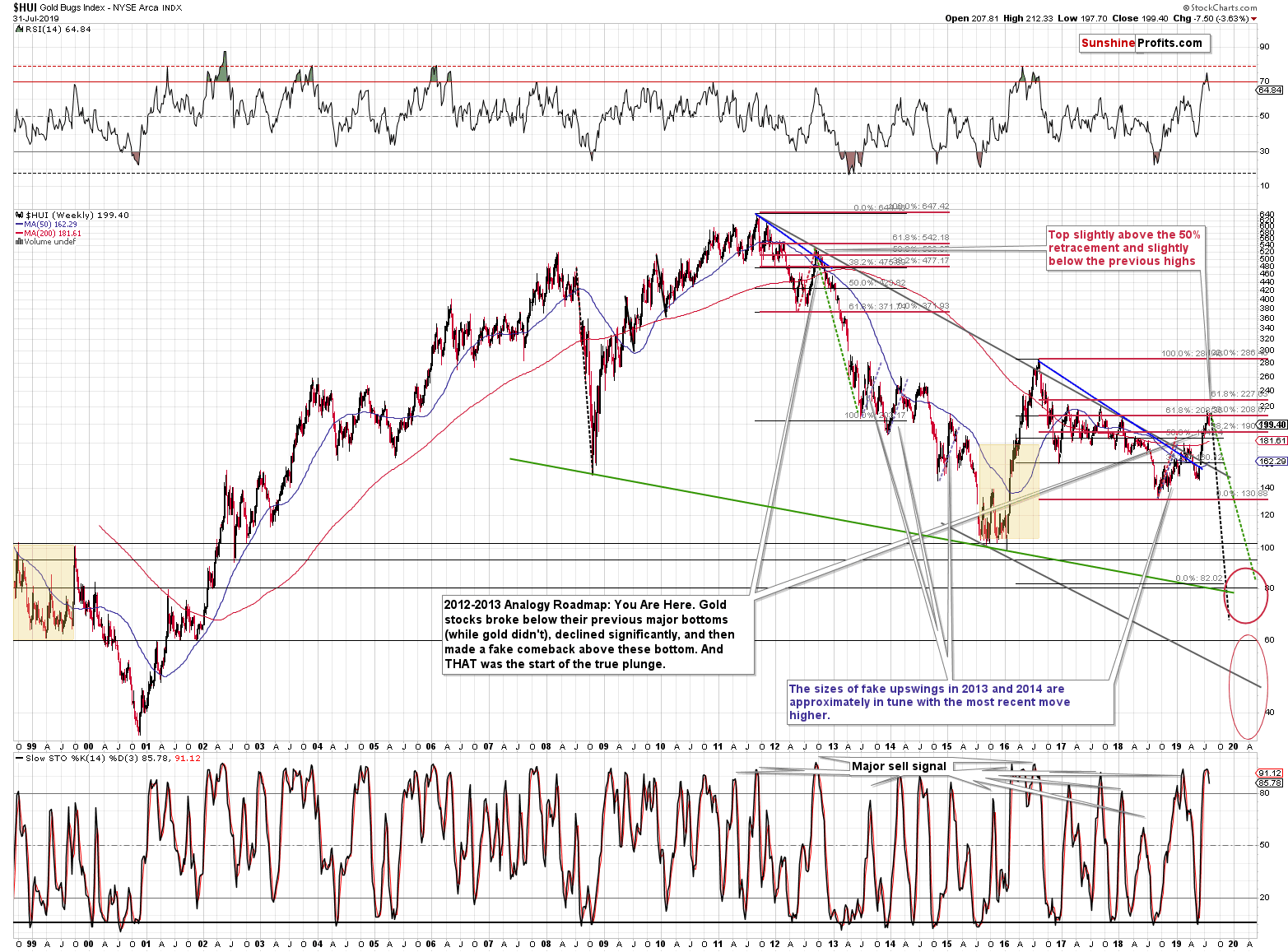Briefly: in our opinion, full (250% of the regular size of the position) speculative short position in gold, silver, and mining stocks is justified from the risk/reward perspective at the moment of publishing this Alert.
The Fed lowered rates and - just as we wrote in yesterday's Alert - gold plunged. The mainstream analysts continue to be baffled by the reaction to a seemingly dovish development, while you knew all along. We explained that it's the expectations that matter and that they were too dovish for what was likely to happen. And what do we have now? We got the first rate cut in years and the USD Index breaking to new highs on their announcement. Ridiculous? Not if you focus on the main trends.
The Trending USD Index
Let's start today's analysis by quoting what we previously wrote about the USD Index and about Trump-Fed conflict:
Trump wants lower dollar in order to boost U.S. exports, economic numbers, and stock prices - the last two are the statistics that will be used to measure the success of his presidency. And he definitely wants it to look as good as possible - that's why he's been pressing so hard for lower interest rates instead of higher ones.
Let's see what happened after the Fed changed its course and bowed to the pressure.
The expectations regarding interest rates are already much lower. But is the U.S. dollar lower?
It's not. Of course, the U.S. currency reacted just as it was supposed to - initially. It declined based on dovish comments. But, once it was all said and done (mostly said), the USD soared back up. It's now very close to its yearly high, even though the expectations regarding interest rates are entirely different.
The Fed sees that lowering rates didn't work and - most importantly - so does Trump. It either already became obvious to him or it will become obvious that the market forces are too strong to keep the U.S. currency at low levels. What then?
Replying to this question is difficult when we think about the economic environment, geopolitics, and financial markets. But it's easy when we get back to the likely core of the decision to keep the dollar lower in the first place.
Trump wants to look good and wants his presidency to be viewed as successful and that's why he wants the lower U.S. dollar. What if we can't get it no matter what he does (which appears to be the case)? Then there's only one thing left to do. Find something or someone else to blame, while allowing the inevitable (rallying USD) to happen. The Fed lowered interest rates? Maybe it didn't lower them soon or significantly enough. Trade war with China? Europe? Or maybe Mexico or the war drums beating on Iran? There will definitely be someone to blame for declining stock market and soaring USD. Trump said so many times that he wants lower USD that if anything unpleasant (plunging stock prices?) happens, it's very easy to blame it on too high USD, which is fault of everyone except him (right?).
The bottom line is that USD's rally is definitely possible despite the current political setups and so is gold's decline.
On the technical note, we wrote the following:
In short, our previous comments on the USD Index chart remain up-to-date as the currency is showing strength, just like we had been expecting it to. The USD Index has more than confirmed the breakout above the inverse head-and-shoulders pattern, which means it's now likely to rally well above the previous 2019 highs. The target is based on the size of the head and it's at about 99.1.
The key thing about this target is that it implies a breakout not only above the recent highs, but also above the running correction pattern that's visible from the long-term point of view.
Breakouts from consolidations are quite often followed by moves similar to the moves that preceded them. The move that preceded the current consolidation was the big 2018 rally. If it is to repeat itself, we're looking at about 105 as the next upside target.
The thing about this target is that it would be a major breakout above the 2017 high, which would then be likely to be followed by yet another rally - to about 108 - 110 area as that's where we have the next strong resistance.
This is a great environment for a decline in the precious metals sector.
Of course, there is the question if the USD Index can really move higher if the interest rates move lower. The answer is yes. Please note where the USD Index currently is - it's very close to its previous 2019 high. And what happened with the Fed's very hawkish tone? It's gone. It changed entirely and the market expectations shifted from expecting higher to expecting lower interest rates. And yet, the USD Index showed exceptional strength and came back up after the initial decline. With this kind of resilience, the U.S. currency can continue to move up even in light of declining interest rates. The U.S. dollar may not be a perfect currency, but it still appears to a better alternative than the euro and the Japanese yen and in the last few months it has already proved its mettle.
That's exactly what happened. The USD Index soared on lower interest rates. The Fed is also being blamed, although not yet by Trump. The key word here is "yet".
The USD Index has been consolidating for a long time and yesterday's breakout to new yearly highs is likely just a beginning of something much more profound.
Also, it's easy to forget the most important and clearest bullish sign for the US currency as it's based on very long-term price moves and since these rarely change, they are rarely commented on. And the foremost technical development for the USD Index is that it's already after a critical breakout and its verification.
The 2016 and 2017 declines seem very important from the medium term point of view, but taking the really big picture into account allows us to see that they were just verifications of the most important development. Namely, they confirmed the breakout above the very long-term declining line based on the critical USD tops. As crazy as it may sound based on the short-term price moves, the long-term chart shows that even an upswing to 120 wouldn't be out of the ordinary given the importance of the breakout. In fact, based on the above chart alone, the USD Index might even move higher than 120 before it tops.
The previous 2 key tops that we see on the above chart were accompanied by major bottoms in gold. The upcoming USD top is likely to correspond to THE bottom in gold as well.
Let's turn to the precious metals sector, starting with gold.
Gold Plunges
We already commented on the above monthly chart yesterday, when we emphasized the importance of the record-breaking monthly volume and the importance of the intraday decline, should one happen (and it did happen):
Even though the month is not yet over, we can already see that the volume that accompanied the July price change was huge. Actually, it's an understatement. It is the biggest monthly volume ever. The other two major monthly volume levels were recorded right at the 2011 top and at the 2018 top (in terms of the monthly closing prices). This alone is something that should make you question the logic behind buying gold now as opposed to buying it after a sizable price decline takes place.
But there's actually more to the big volume than the above. We mentioned this gold trading tip numerous times, but it's worth repeating once again. The reversals, for instance the shooting star candlesticks, need to be confirmed by sizable volume in order to be reliable. The volume is already extreme.
"Wait, we don't have any reversal candlestick just yet."
That's true, but today is the final day of the month, and it's the day when the Fed provides critical clues and that means that gold could change its course quite rapidly. It's certainly possible that gold rallies based on the - likely - interest rate cut, but let's keep in mind that gold might actually decline even though the Fed is likely to lower the interest rates. Why? Because practically everyone expects the rates to be lowered, while some investors expect them to be lowered by 50 basis points, not just 25. They are likely to be disappointed (the Fed is unlikely to shoot a bazooka as a warning, insurance shot), which means that the interest rate decision - even though it is likely to be a rate cut - might be actually viewed as something hawkish. Again - not because it is such per se, but because it is hawkish compared to the average expectations.
Quite a lot will depend on what the Fed says during the press conference, so the final part of today's session will likely be quite volatile. And the implications of the entire monthly price changes will depend on it. The volume is already huge, so it will confirm what happens in terms of price. If gold rallies, we will have a conflict between bearish implications of huge volume per se, and bullish implications of a rally on big volume. But, when gold reverses this month, the extreme volume will make the gold reversal very, very, very profound.
The final monthly volume was definitely extreme, but the monthly candlestick chart that we see above looks rather normal - it doesn't appear to be any kind of reversal. The critical detail here is yesterday's closing price. On the above chart it seems that gold closed the day and month at $1,437.80. But was this really the case?
The above chart shows gold's (spot gold) intraday performance. The NYMEX trading did stop without a major decline, but this doesn't really tell the full truth about gold's performance yesterday. Gold plunged to almost $1,400 just a few hours later and it movec lower earlier today, so should the relatively high price that we see on the previous gold chart really count?
But spot gold price might have behaved differently than gold futures!
Indeed, so let's take a look at the overnight performance of gold futures (based on finance.yahoo.com data).
It doesn't look too bullish either, does it? It looks like gold really closed at about $1,410. In most (almost all) cases the Stockcharts data does a good job representing the market performance, but this single session is too important not to take a look at it from many angles before discussing implications.
Previous month's closing price was about $1,414, which means that gold really declined a few dollars, thus forming a doji candlestick. And guess what - doji is one of the reversal candlesticks that can be confirmed by big volume. The volume was epic, which means that the real implications of the July price changes in gold are very bearish for the following months.
Let's take a look at the short-term throughout the precious metals.
The Day-to-day PMs Changes
In order to make the above chart more useful, we added red lines as today's pre-market price movement. Gold is currently breaking below its pennant pattern while silver broke back below $16 and the February 2019 high. These are bearish signs for the short term.
The gold miners are not yet trading, but given gold's and silver's pre-market decline they are very likely to continue their slide today. Even without it, yesterday's slide clearly shows that the short-term trend is down. We previously emphasized that the HUI Index confirmed its breakdown below the rising support line and that the next move is going to be lower. Yesterday's (and likely today's) price action confirms that this is indeed the case.
Before summarizing, we would like to put the yesterday's decline and its today's continuation into proper perspective. Namely, that's just a tiny start and we have barely seen anything yet (compared to what's likely to come).
Let's start by quoting what we wrote about silver's long-term chart and then we'll move to gold miners' big picture.
The Long-Term PMs View
There is actually much more to the silver story than just a breakout above the recent highs. In fact, the breakout itself is not that important. What is important, is the resistance that was just reached and how it relates to what we saw in the past.
By "resistance" we actually mean two resistance levels. One is created based on the line that's parallel to the rising support line created by connecting the 2018 and 2019 bottoms. Copying this line and moving it higher so that it touches the early 2019 high creates the upper border of the rising trend channel. This is silver's second move higher and the "C" part of a rising ABC correction pattern (the late-2018 - early-2019 rally was the "A" part of the move and the subsequent decline was "B"). The ABC corrections (a.k.a. zigzags) are relatively common corrective patterns that don't change the preceding trend. In this case, the trend was down.
We can speak of the big downtrend that started in 2011, or we can speak of the more medium-term downtrend that started in 2016 - either way, the corrective ABC pattern seems to have already run its course as silver moved to the upper border of the trend channel.
There is also additional reason for silver to turn south from the current price levels that's even more important. Taking the 2016 top as the starting price for the decline and using the 2018 bottom as the final (so far) bottom, we get $16.70 as the 38.2% Fibonacci retracement. This is a good reason on its own for silver to turn around, especially if we also consider the fact that silver moved to the above-mentioned upper border of the trade channel.
The extremely bearish outlook comes from something else, though. There are many things that emphasize that the outlook is extremely bearish (such as the recent volume readings in silver and silver stocks), but with regard to the price level that was reached yesterday, there is one more very important detail that most investors will likely miss.
The entire 2016 - now situation and the 2011 - late-2012 price movement are very similar.
In both cases there were actually four bottoms at very similar price levels that preceded the final upswing and the first one of them was very sharp (late 2011 and mid-2017). The timing between the following bottoms was different, but there are two major similarities that just can't be ignored or left unmentioned.
The first thing is that all major tops were lower than the previous ones. The only outlier is the early-2019 top, which - as it turned out - wasn't the final top for the rally, so overall it seems that the analogy remains intact.
The second thing is that the top (the one in early 2012) that preceded the final top of the consolidation is extremely similar to the mid-2018 one and this an extremely useful roadmap sign that tells us where silver is in light of the entire analogy.
The key thing is that the final pre-slide (late-2012) top formed at the 38.2% Fibonacci retracement level based on the preceding decline. The early 2012 top formed slightly below the 50% retracement (intraday high) and the weekly close was a bit below the 38.2% retracement. The mid-2018 top (analogous to the late-2012 one) also formed a bit below the 50% retracement and the weekly close of that top was a bit below the 38.2% retracement.
This means that if the analogy remains intact, silver should top at the 38.2% retracement right now, which is at $16.70. And what was silver's high yesterday? $16.68 - almost exactly the level of the retracement. This price level is today's pre-market high based on finance.yahoo.com and stooq.com prices.
The top that was just reached is likely much more important than it seems based on just today's intraday chart.
The extremely bearish implications remain intact and the same goes for what we wrote about the long-term HUI Index chart:
The above gold stock chart continues to highlight how similar the current situation is to what we saw in late 2012. People are very excited by gold miners' gains and the same was the case in 2012. Back then people were practically sure that gold and gold miners are going to move to new highs shortly. We have many investors and analysts thinking the same thing right now. What really followed in the past, was the biggest decline that we saw in the past several decades.
(...) Back in late 2012, the HUI Index moved a bit above its 50% retracement of the preceding decline before the top was formed. The analogous retracement is currently at about 208.
(...) Why is the situation likely to repeat itself? Because this is what generally tends to happen in the market. Not every time, but often enough to make it worth one's while to look for the similarities. The more similar the moves are, the more likely it is that the follow-up action will be similar as well. Please note that the shape of the 2018 - now rally is also similar to the one that we saw in 2012. The entire rally consisted of two parts that were separated by a decline that started from the 200-week moving average (marked with red). The second rally was sharper and bigger than the initial one. We see the same thing right now. In yesterday's first Alert, we emphasized the similarity with regard to volume in silver - the late-2012 top was one of the cases that were similar to the current situation.
Of course, just as it was the case in late 2012, we now have multiple analysts and investors that are convinced that the entire precious metals market is taking off to new highs. But will this really be the case? We doubt it.
(...) please consider the current breakout above 200 and how similar it is to the early 2016 breakdownbelow the 100 level. Both numbers are very round, and in both cases, gold miners moved to new extremes even though gold didn't. In 2016 the fake breakdown meant the start of the biggest rally in years. With the current strength, are we about to see the biggest decline in years? This appears very likely, also based on silver's outperformance and SLV's epic volume that we discussed [previously].
The rally is now practically just as big as it was in the late 2012 - naturally in relative terms. The HUI Index is slightly above the 50% Fibonacci retracement, not yet at the 61.8% retracement, and a bit below the previous highs. In this case, these are the 2017 highs, and in the past, these were the early 2012 highs.
Summary
Summing up, the gold and silver slide on the heels of the interest rate cut is the perfect confirmation of the multiple long-, medium-, and short-term signs that have been pointing to much lower precious metals prices. The decline may seems significant from the short-term basis, but in reality it's next to nothing compared to the powerful plunge that is likely to follow. There will most likely be times when gold is trading well above the 2011 highs, but they are unlikely to be seen without being preceded by a sharp drop first.
As always, we'll keep you - our subscribers - informed.
To summarize:
Trading capital (supplementary part of the portfolio; our opinion): Full short position (250% of the full position) in gold, silver, and mining stocks are justified from the risk/reward perspective with the following stop-loss orders and exit profit-take price levels:
- Gold: profit-take exit price: $1,241; stop-loss: $1,468; initial target price for the DGLD ETN: $51.87; stop-loss for the DGLD ETN $30.27
- Silver: profit-take exit price: $13.81; stop-loss: $16.73; initial target price for the DSLV ETN: $39.08; stop-loss for the DSLV ETN $22.87
- Mining stocks (price levels for the GDX ETF): profit-take exit price: $17.61; stop-loss: $29.27; initial target price for the DUST ETF: $32.28; stop-loss for the DUST ETF $6.88
In case one wants to bet on junior mining stocks' prices (we do not suggest doing so - we think senior mining stocks are more predictable in the case of short-term trades - if one wants to do it anyway, we provide the details), here are the stop-loss details and target prices:
- GDXJ ETF: profit-take exit price: $23.71; stop-loss: $43.47
- JDST ETF: profit-take exit price: $73.32 stop-loss: $13.87
Long-term capital (core part of the portfolio; our opinion): No positions (in other words: cash)
Insurance capital (core part of the portfolio; our opinion): Full position
Whether you already subscribed or not, we encourage you to find out how to make the most of our alerts and read our replies to the most common alert-and-gold-trading-related-questions.
Please note that the in the trading section we describe the situation for the day that the alert is posted. In other words, it we are writing about a speculative position, it means that it is up-to-date on the day it was posted. We are also featuring the initial target prices, so that you can decide whether keeping a position on a given day is something that is in tune with your approach (some moves are too small for medium-term traders and some might appear too big for day-traders).
Plus, you might want to read why our stop-loss orders are usually relatively far from the current price.
Please note that a full position doesn't mean using all of the capital for a given trade. You will find details on our thoughts on gold portfolio structuring in the Key Insights section on our website.
As a reminder - "initial target price" means exactly that - an "initial" one, it's not a price level at which we suggest closing positions. If this becomes the case (like it did in the previous trade) we will refer to these levels as levels of exit orders (exactly as we've done previously). Stop-loss levels, however, are naturally not "initial", but something that, in our opinion, might be entered as an order.
Since it is impossible to synchronize target prices and stop-loss levels for all the ETFs and ETNs with the main markets that we provide these levels for (gold, silver and mining stocks - the GDX ETF), the stop-loss levels and target prices for other ETNs and ETF (among other: UGLD, DGLD, USLV, DSLV, NUGT, DUST, JNUG, JDST) are provided as supplementary, and not as "final". This means that if a stop-loss or a target level is reached for any of the "additional instruments" (DGLD for instance), but not for the "main instrument" (gold in this case), we will view positions in both gold and DGLD as still open and the stop-loss for DGLD would have to be moved lower. On the other hand, if gold moves to a stop-loss level but DGLD doesn't, then we will view both positions (in gold and DGLD) as closed. In other words, since it's not possible to be 100% certain that each related instrument moves to a given level when the underlying instrument does, we can't provide levels that would be binding. The levels that we do provide are our best estimate of the levels that will correspond to the levels in the underlying assets, but it will be the underlying assets that one will need to focus on regarding the signs pointing to closing a given position or keeping it open. We might adjust the levels in the "additional instruments" without adjusting the levels in the "main instruments", which will simply mean that we have improved our estimation of these levels, not that we changed our outlook on the markets. We are already working on a tool that would update these levels on a daily basis for the most popular ETFs, ETNs and individual mining stocks.
Our preferred ways to invest in and to trade gold along with the reasoning can be found in the how to buy gold section. Additionally, our preferred ETFs and ETNs can be found in our Gold & Silver ETF Ranking.
As a reminder, Gold & Silver Trading Alerts are posted before or on each trading day (we usually post them before the opening bell, but we don't promise doing that each day). If there's anything urgent, we will send you an additional small alert before posting the main one.
=====
Latest Free Trading Alerts:
Yesterday, the Fed trimmed down the interest rates. This was widely expected - yet a blunt ruling out of an extended easing cycle wasn't. The price of gold profoundly declined. Looking beneath the headline, what happened exactly?
Hawkish Rate Cut Sends Gold Prices Down
Stocks turned lower on Wednesday, as investors reacted to the Fed's interest rate cut. The S&P 500 index broke below the 3,000 mark and it got closer to the early May local high of around 2,954. Then the index slightly bounced before closing 1.1% lower. So is this a new downtrend or just a quick correction within an uptrend?
Stocks Going Lower After Fed, Were We Right About the Topping Pattern?
=====
Thank you.
Sincerely,
Przemyslaw Radomski, CFA
Editor-in-chief, Gold & Silver Fund Manager


